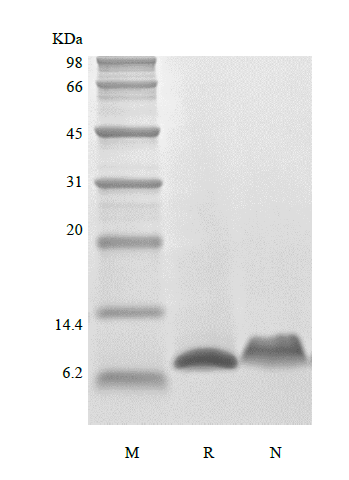- Synonyms
- MuRantes, SIS-delta, Small-inducible cytokine A5, T-cell-specific protein RANTES
- Source
- Escherichia coli.
- Molecular Weight
- Approximately 7.9 kDa, a single non-glycosylated polypeptide chain containing 68 amino acids.
- AA Sequence
- SPYGSDTTPC CFAYLSLALP RAHVKEYFYT SSKCSNLAVV FVTRRNRQVC ANPEKKWVQE YINYLEMS
- Purity
- > 97 % by SDS-PAGE and HPLC analyses.
- Biological Activity
- Fully biologically active when compared to standard. The biological activity determined by a chemotaxis bioassay using human T lymphocytes is in a concentration range of 1.0-10 ng/ml.
- Physical Appearance
- Sterile Filtered White lyophilized (freeze-dried) powder.
- Formulation
- Lyophilized from a 0.2 µm filtered concentrated solution in 30 % Acetonitrile and 0.1 % TFA.
- Endotoxin
- Less than 1 EU/µg of rMuRANTES/CCL5 as determined by LAL method.
- Reconstitution
- We recommend that this vial be briefly centrifuged prior to opening to bring the contents to the bottom. Reconstitute in sterile distilled water or aqueous buffer containing 0.1 % BSA to a concentration of 0.5-1.0 mg/mL. Stock solutions should be apportioned into working aliquots and stored at ≤ -20 °C. Further dilutions should be made in appropriate buffered solutions.
- Stability & Storage
- Use a manual defrost freezer and avoid repeated freeze-thaw cycles.
- 12 months from date of receipt, -20 to -70 °C as supplied.
- 1 month, 2 to 8 °C under sterile conditions after reconstitution.
- 3 months, -20 to -70 °C under sterile conditions after reconstitution.
- Usage
- This material is offered by Shanghai PrimeGene Bio-Tech for research, laboratory or further evaluation purposes. NOT FOR HUMAN USE.
- SDS-PAGE

- Reference
- 1. Donlon TA, Krensky AM, Wallace MR, et al. 1990. Genomics. 6:548-53.
2. Maghazachi AA, Al-Aoukaty A, Schall TJ. 1996. Eur J Immunol. 26:315-9.
3. Cocchi F, DeVico AL, Garzino-Demo A, et al. 1995. Science. 270:1811-5.
- Background
- Chemokine (C-C motif) ligand 5 (CCL5) also known as RANTES is classified as a chemotactic cytokine or chemokine. It is encoded by the CCL5 gene in humans. CCL5 is chemotactic for T cells, eosinophils, and basophils, and plays an active role in recruiting leukocytes into inflammatory sites which has been reported to be produced by renal tubular epithelium, synovial fibroblasts and selected tumor cells. In addition, it also induces the proliferation and activation of certain natural-killer cells to form CHAK cells. Recombinant murine CCL5, a single non-glycosylated polypeptide, contains 68 amino acids and it shares 84 % and 100 % a.a. sequence identity with human and rat CCL5.










 COA Application
COA Application


